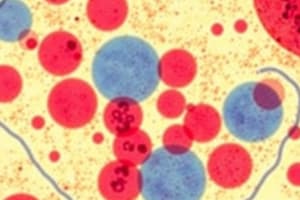Podcast
Questions and Answers
How does Mean Corpuscular Volume (MCV) assist in the classification of red blood cells?
How does Mean Corpuscular Volume (MCV) assist in the classification of red blood cells?
- It evaluates the presence of reticulocytes in the blood.
- It measures the average hemoglobin content of red blood cells.
- It indicates the oxygen-carrying capacity of the blood.
- It determines the average diameter of red blood cells. (correct)
Which laboratory test is crucial for distinguishing between patients with a functional bone marrow response to anemia and those with a failed response?
Which laboratory test is crucial for distinguishing between patients with a functional bone marrow response to anemia and those with a failed response?
- Hematocrit measurement.
- Mean Corpuscular Hemoglobin (MCH) test.
- Peripheral blood smear analysis.
- Reticulocyte count. (correct)
What is indicated by a reticulocyte production index (RPI) greater than three times the normal level in response to anemia?
What is indicated by a reticulocyte production index (RPI) greater than three times the normal level in response to anemia?
- A normal response to anemia.
- An appropriate marrow response to anemia. (correct)
- Hemolysis of red blood cells.
- A failed response in marrow activity.
What can variations in the peripheral blood smear, such as cell diameter and shape, indicate?
What can variations in the peripheral blood smear, such as cell diameter and shape, indicate?
Which of the following describes reticulocytes in terms of their cellular content?
Which of the following describes reticulocytes in terms of their cellular content?
What is the significance of measuring RDW-CV in blood tests?
What is the significance of measuring RDW-CV in blood tests?
Which laboratory test helps differentiate between thalassemia and iron deficiency anemia?
Which laboratory test helps differentiate between thalassemia and iron deficiency anemia?
In what condition would you expect to see elevated RDW?
In what condition would you expect to see elevated RDW?
What does an increase in RDW suggest regarding red blood cell populations?
What does an increase in RDW suggest regarding red blood cell populations?
What role do reticulocytes play in the evaluation of anemia?
What role do reticulocytes play in the evaluation of anemia?
Flashcards are hidden until you start studying
Study Notes
Peripheral Blood Smear
- Peripheral blood smear is a valuable tool to compliment automated counter measurements of MCV and MCH
- Visible changes in cell diameter, shape, and hemoglobin content can help distinguish microcytic and macrocytic cells from normocytic/normochromic RBCs.
Reticulocyte Count
- Essential component of CBC, plays a crucial role in classifying anemia
- Reticulocytes are newly formed red blood cells with residual strands of nuclear material called “reticulin”
- Reticulocytes are young red blood cells containing residual ribosomal RNA, stained with supravital dyes like acridine orange or new methylene blue
- Reticulocyte count helps differentiate patients with a functionally normal marrow response to anemia/hypoxia and those with a failed marrow response.
Red Blood Cell Distribution Width (RDW)
- RDW-SD is calculated by measuring the width at the 20% height level of the red blood cell size distribution histogram.
- RDW measures the variation in size of red blood cells, a higher RDW reflects a wider range of sizes.
- RDW-SD is more sensitive to minor populations of macrocytes or microcytes.
- RDW can distinguish thalassemia (normal RDW) from iron deficiency anemia (high RDW)
- RDW increases in iron deficiency anemia, vitamin B12 or folate deficiency (pernicious anemia), abnormal Hb (S, S-C, or H), S-β thalassemia, immune hemolytic anemia, marked reticulocytosis, and posthemorrhagic anemia.
Stained Peripheral Blood Smear
- Peripheral blood smears provide crucial information regarding RBC morphology in anemia
- Typically prepared manually, using glass slides
- Hematology laboratory typically examines a peripheral blood smear when a patient's indices are abnormal.
Complete Blood Count (CBC)
- CBC includes hemoglobin (Hb) concentration, white blood cell (WBC) count, and manual platelet count.
- Modern analyzers use various physical and chemical methods such as electronic impedance, laser light scattering, light absorption, and staining properties to measure these parameters.
- CBC identifies several different parameters and can provide significant information like a high WBC count could signify an infection.
Laboratory Evaluation of Anemia
- A comprehensive laboratory evaluation is required for definitive diagnosis and treatment of anemia.
- Anamnesis (history of patient) and physical examination might indicate the presence of anemia and suggest the cause.
- Routine hematological tests like CBC and reticulocyte counts as well as iron status studies serve as a starting point in the diagnosis.
- Laboratory results obtained from these parameters are vital arguments in the diagnosis, treatment, and monitoring of anemias.
Studying That Suits You
Use AI to generate personalized quizzes and flashcards to suit your learning preferences.



